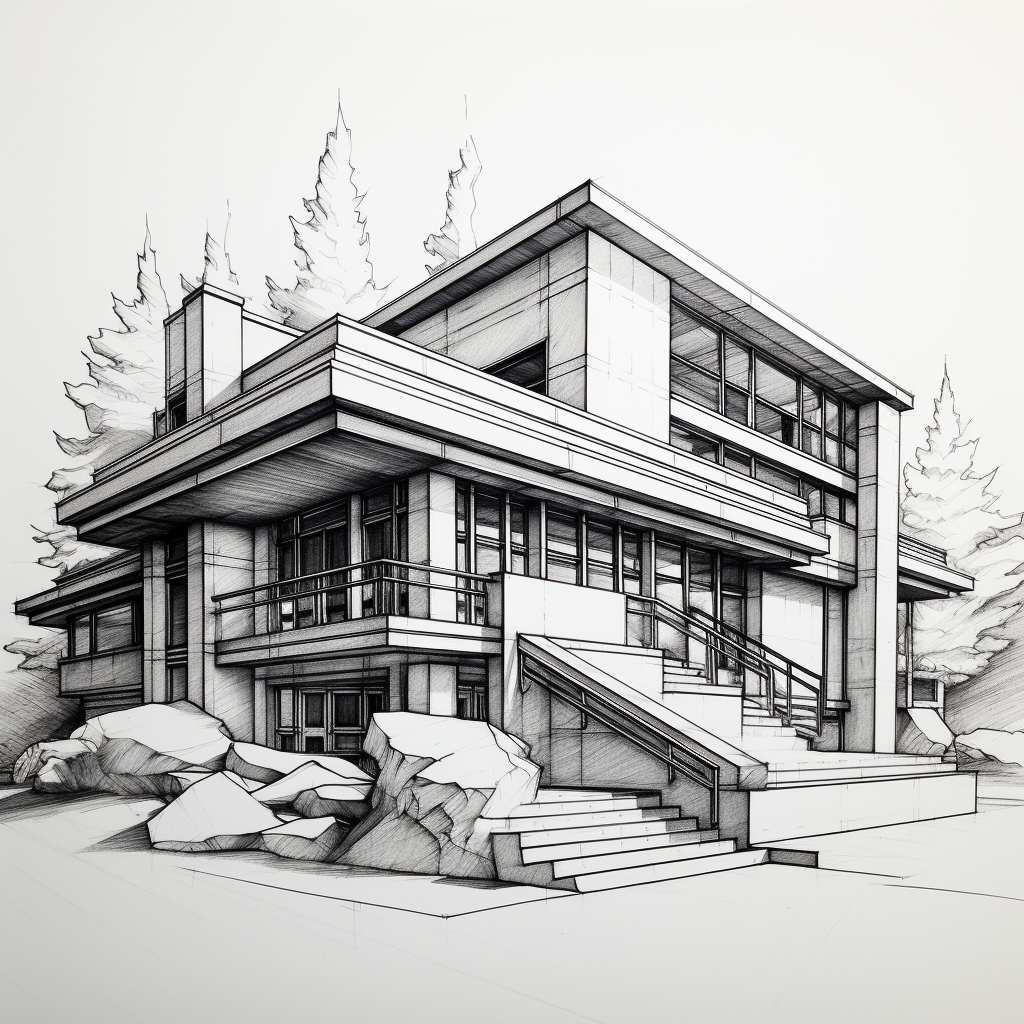Architecture AI | Generate AI Architecture Design from Draft Blueprint!
Architect AI is a cutting-edge tool that leverages advanced AI algorithms to generate innovative and efficient architectural designs with just one prompt, streamlining the design process and enhancing creativity for architects and designers.
Introduction
| Draft blueprint | Rended Output Generated by Architecture AI |
|---|---|
 |  |
Architect AI: Revolutionizing Architectural Design with One Prompt
The integration of AI architecture tools into the field of architecture has brought about a significant transformation. These tools enable architects to generate complex designs with a single prompt, streamlining the design process and enhancing creativity. This article explores the various aspects of architect ai and how it is revolutionizing the industry.
1. What is Architect AI?
Architect AI is an advanced tool that uses artificial intelligence to generate architectural designs from a single prompt. It helps architects and designers create innovative and efficient building designs quickly and easily.
2. How does Architect AI work?
Architect AI works by analyzing input parameters such as site conditions, building codes, and user preferences. It then uses AI algorithms to generate multiple design options, providing real-time feedback and optimization to help architects select the best design.
3. What are the benefits of using Architect AI?
The benefits of using Architect AI include increased efficiency, enhanced creativity, improved accuracy, sustainability, and cost savings. It automates repetitive tasks, provides data-driven insights, and allows architects to focus on more complex and creative aspects of the design process.
4. Can Architect AI be used for all types of architectural projects?
Yes, Architect AI can be used for a wide range of architectural projects, including residential, commercial, and industrial buildings. It is versatile and can adapt to various design requirements and constraints.
5. Is Architect AI suitable for small architectural firms?
Yes, Architect AI is suitable for small architectural firms. While there may be initial costs for implementation, the tool's efficiency and cost-saving benefits can make it a valuable investment for firms of all sizes.
The Role of AI in Architecture
AI architecture tools leverage advanced algorithms and machine learning to assist architects in creating innovative and efficient designs. These tools can analyze vast amounts of data, generate multiple design options, and optimize building performance, all with minimal human intervention. The primary goal of ai architecture design is to augment the capabilities of architects, allowing them to focus on creativity and decision-making.
Key Features of AI Architecture Tools
1. Generative Design
Generative design is a core feature of ai architecture tools. It allows architects to input specific parameters, such as site conditions, building codes, and user preferences, and the AI generates multiple design alternatives. This process enables architects to explore a wide range of possibilities and select the most optimal design.
2. Real-Time Feedback
AI architecture tools provide real-time feedback on design decisions. This includes insights into structural integrity, energy efficiency, and compliance with regulations. By receiving instant feedback, architects can make informed decisions and iterate on their designs quickly.
3. Data-Driven Insights
AI for architecture leverages data from various sources, including historical projects, environmental data, and user behavior. This data-driven approach helps architects create designs that are not only aesthetically pleasing but also functional and sustainable.
4. Automation of Repetitive Tasks
AI architecture design tools can automate repetitive tasks such as drafting, modeling, and rendering. This automation frees up architects' time, allowing them to focus on more complex and creative aspects of the design process.
Popular AI Architecture Tools
Several ai architecture tools have gained popularity among architects and designers. Here are some notable ones:
1. ARCHITEChTURES
ARCHITEChTURES is a generative ai architecture platform that helps architects design optimal residential developments in minutes. It allows users to input design criteria and generates real-time solutions that best fit the parameters. The platform also provides instant feedback on rule violations, material selection advice, and cost estimation tools.
2. Maket.ai
Maket.ai is an AI-based software platform designed for automated architectural planning. It generates thousands of plans swiftly based on client requirements and environmental constraints. The platform's cloud-based architecture facilitates real-time collaboration on projects.
3. DALL·E 3
Developed by OpenAI, DALL·E 3 is an AI-powered image creator that allows architects to generate visuals rapidly with a simple text or keyword input. This tool is particularly useful for quick ideation and rendering of concepts.
4. Midjourney
Midjourney is an AI-driven text-to-image generator that facilitates the creation of hyper-realistic environments. It offers 3D rendering of existing photos or sketches and real-time project previewing with natural elements.
5. Spacemaker
Spacemaker is a cloud-based AI software that empowers architects, urban planners, and real estate developers to make smarter decisions faster. It helps users design better buildings while saving time and money.
Applications of AI in Architecture
AI architecture tools have a wide range of applications across different stages of the architectural process:
1. Concept Design
In the early stages of a project, ai architecture design tools can generate multiple design concepts based on input parameters. This allows architects to explore various ideas and select the most promising ones for further development.
2. Schematic Design
During the schematic design phase, ai architecture tools can optimize floor plans, space utilization, and energy efficiency. This ensures that the design meets all functional and regulatory requirements.
3. Detailed Design
In the detailed design phase, ai architecture tools can automate the creation of detailed drawings, model annotations, and specifications. This reduces the likelihood of human error and streamlines the documentation process.
4. Visualization
AI architecture tools can generate realistic and interactive 3D visualizations of architectural projects. These visualizations are crucial for effective communication between architects and stakeholders, ensuring that all parties clearly understand the proposed designs.
5. Construction
During the construction phase, ai architecture tools can assist in project management, cost estimation, and scheduling. This helps ensure that the project stays on track and within budget.
Benefits of AI in Architecture
The integration of ai architecture tools offers several benefits:
1. Increased Efficiency
AI architecture tools can significantly reduce the time and effort required to produce design iterations. This allows architects to work more efficiently and explore a wider range of design possibilities.
2. Enhanced Creativity
By automating repetitive tasks, ai architecture tools free up architects' time, allowing them to focus on creativity and innovation. This leads to more unique and imaginative designs.
3. Improved Accuracy
AI architecture tools provide data-driven insights and real-time feedback, ensuring that designs are accurate and compliant with regulations. This reduces the likelihood of errors and rework.
4. Sustainability
AI architecture tools can analyze environmental data and optimize designs for energy efficiency and sustainability. This helps architects create buildings that are not only functional but also environmentally friendly.
5. Cost Savings
By streamlining the design process and optimizing resource utilization, ai architecture tools can help reduce project costs. This is particularly beneficial for smaller firms with limited budgets.
Challenges and Limitations
While ai architecture tools offer numerous benefits, there are also challenges and limitations to consider:
1. Loss of Human Intuition
One of the primary concerns with ai architecture is the potential loss of human intuition and creativity. Architecture is as much an art as it is a science, and over-reliance on AI tools could lead to homogenized designs that lack the unique touch of human architects.
2. Data Accuracy
AI architecture tools rely heavily on data. Inaccurate or biased data can lead to flawed design suggestions. Architects must ensure that the data used in the design process is accurate and comprehensive.
3. Ethical Considerations
The use of ai architecture tools raises ethical concerns, particularly regarding job displacement and data privacy. Architects must navigate these ethical dilemmas responsibly and ensure that AI is used to augment human capabilities rather than replace them.
4. Cost of Implementation
The cost of implementing ai architecture tools can be significant, particularly for smaller firms. This includes the cost of software, training, and data management. Architects must weigh the benefits against the costs to determine if AI is a viable investment.
5. Integration with Existing Systems
Integrating ai architecture tools with existing systems and workflows can be challenging. This may require additional infrastructure and training, as well as potential compatibility issues.
The Future of AI in Architecture
The future of ai architecture is promising, with continued advancements in technology and increased adoption by architects and designers. Here are some potential future developments:
1. Enhanced Collaboration
Future ai architecture tools will likely offer enhanced collaboration features, allowing architects to work seamlessly with other stakeholders. This includes real-time collaboration, version control, and integrated communication tools.
2. Advanced Material Analysis
AI architecture tools will continue to improve in their ability to analyze and recommend building materials. This includes considerations for sustainability, cost, and performance, helping architects make more informed decisions.
3. Integration with IoT
The integration of ai architecture tools with the Internet of Things (IoT) will enable real-time data collection and analysis. This will provide architects with valuable insights into building performance and user behavior, allowing for continuous optimization.
4. Personalized Design
Future ai architecture tools will offer more personalized design options, taking into account individual preferences and needs. This will enable architects to create customized spaces that better meet the requirements of their clients.
5. AI-Driven Construction
The use of AI in construction will continue to grow, with AI-powered robots and automation tools taking on more tasks. This will increase efficiency, reduce costs, and improve safety on construction sites.
Conclusion
The integration of ai architecture tools is revolutionizing the field of architecture, offering numerous benefits in terms of efficiency, creativity, and sustainability. While there are challenges and limitations to consider, the potential of ai architecture is immense. By embracing these tools responsibly, architects can push the boundaries of design and create innovative, functional, and sustainable buildings. The future of architecture lies in the harmonious blend of human creativity and AI-driven efficiency, paving the way for a new era of architectural excellence.
